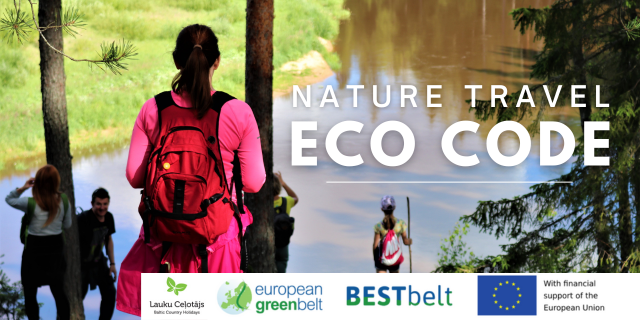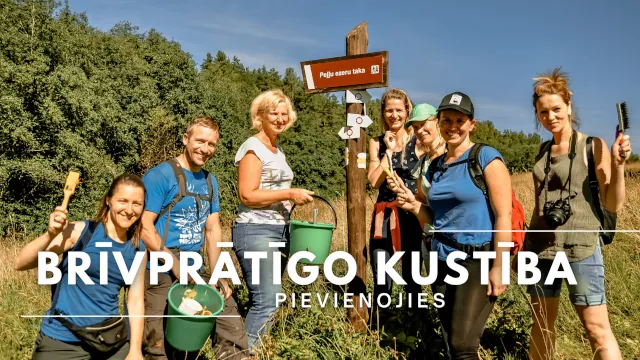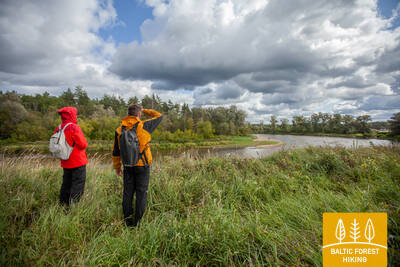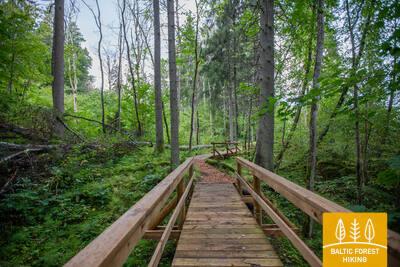Baltic Forest Hiking - Riga and Riga Region
Riga and Pieriga
THE PICTURESQUE CONTRAST REGION – FROM TOWERS TO FORESTS AND CLIFFS
Old Riga – Rāmkalni: 54 km, Day 1 – 3
The city of Riga is surrounded by forests, which means that if you begin your hike in the heart of the city, in a couple of hours you will find yourself in a beautiful coniferous forest. The trail leads through a wooded coastal dune area, along Gauja River and along a historical postal road which was once used to travel to neighbouring countries. In early summer, the meadows show a magnificent display of blooming catchflies.
Highlights: Old Riga – UNESCO World heritage site, Freedom Monument and Latvian National Opera House, Riga Central Market – historical aircraft (zeppelin) hangars, The cultural and natural heritage of Vērmane Garden park, Art Nouveau buildings on Tērbatas Street, The Ethnographic Open-Air Museum of Latvia, Riga water supply museum – industrial heritage, Garden of Artists by Anna Ludiņa, Inčukalns Hunting Palace, Hunting trail and Inčukalns Velnala (Devil’s) Cave.
 Section 1. Old Riga - Baltezers.
Section 1. Old Riga - Baltezers.
Through Riga – UNESCO World Heritage Site
The starting point of Forest Trail in Latvia is located in the heart of Old Riga, the Town Hall Square. The route leads along Kaļķu Street, passes the Monument of Freedom, through Vērmane Garden and along the historic Tērbatas street. Then it arches over the Zemitāni railway station pedestrian bridge and treads into Biķernieki and Šmerlis forests. The Forest Trail winds through Jugla, passes the Latvian Ethnographic Open-Air Museum and goes on along the pedestrian-bicycle path until Baltezers.
 Section 2. Baltezers - Vangaži.
Section 2. Baltezers - Vangaži.
The historic Tērbata road along the banks of Gauja River and lakes
The Forest Trail crosses the VIA Baltica motorway via a tunnel and goes on through a private housing along the Lake Mazais Baltezers. Then it turns east, following the Gauja-Baltezers Canal. In the Garkalne–Āņi section, beautiful meadows stretch on both sides of the Forest Trail, drowning in heaps of blossoming red catchflies, white daisies and yellow buttercups during the summer. Since days of old, medieval roads have ran along the banks of Gauja River, and travellers used the ferry crossing at Iļķene to get across. Beyond Āņi, the Forest Trail passes through forested areas and a populated country area, and finally reaches Vangaži via Gaujas street.
 Section 3. Vangaži - Rāmkalni.
Section 3. Vangaži - Rāmkalni.
Along Inčukalns hunting palace towards Gauja National Park
After leaving Vangaži, the Forest Trail leads through smaller paths, reaching Vangaži Lutheran Church and the Werewolf Pine. On its way to the Hunting Palace, it goes along the so-called Katrīna Road, disappears into the forest for a while and after the Hunting Castle continues along the Hunting trail. The first side ravines with pronounced relief of the ancient Gauja valley can be seen here. One of them is located by Inčukalns Velnala (Devil’s) Cave, surrounded by small river channels of old Gauja. From there, the Forest Trail continues through meadows and crosses the Murjāņi–Valmiera motorway, where the recreation park “Rāmkalni” is located.














